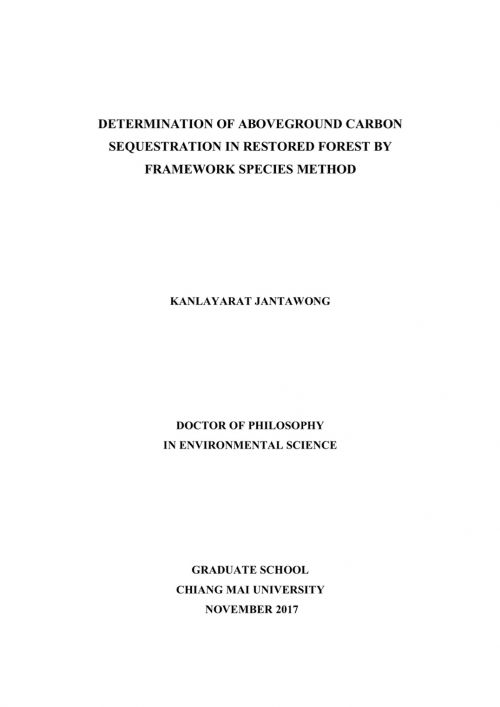Determination of aboveground carbon sequestration in restored forest by framework species method

FORRU Contributors
ABSTRACT: Tropical deforestation reduces the global terrestrial carbon sink and substantially contributes towards global climate change. Conversely, tropical forest restoration could help to mitigate the problem, but few measurements of how much carbon can be absorbed by forest restoration have been published. The objectives of the research presented here were therefore, to determine the above-ground carbon storage of restored forest and determine above-ground carbon-uptake rates of trees at the species level. Such information can support the efficient design of forest restoration projects for carbon sequestration and contribute towards the development of proper methods of forest restoration management, to both recover biodiversity and maximize carbon storage. This study used a partial harvesting method, to assess above-ground biomass and compare carbon sequestration among 11 framework tree species (selected to accelerate forest regeneration by suppressing weeds and attracting seed dispersers), in restoration plots, aged 5, 10 and 14 years old in northern Thailand. Above-ground carbon sequestration was derived from wood density, tree volume and above-ground biomass of 3 trees of each of 11 tree species, in 5, 10 and 14-year old restoration plots (RF5, RF10 and RF14, respectively). Carbon concentration of stem wood did not vary significantly among the tree species tested or age of restoration (p ≤ 0. 05), averaging 44.67% (±0.54). In the oldest plot (RF14), Erythrina subumbrans grew significantly larger than the other species and sequestered the most above-ground carbon: 135.23 kgC/tree. Mean above-ground carbon sequestration per tree, across species for trees aged 5, 10 and 14 years old, was 9.4, 29.0 and 48.8 kgC/tree respectively. When considering above-ground carbon, sequestered on a scale of per hectare, natural forest (located nearby restoration plots) sequestered 181.5 tC/ha, which higher than that of a 40-year-old plantation nearby at 124.1 tC and plot R14, 105.9 tC/ha. Models, based on the field data, predicted a return to the above-ground carbon levels, typical of nearby mature forest by 16-17 years after implementation of forest restoration.
Eight framework tree species were tested for carbon uptake ability at the leaf-level using LICOR (model LI-6400) at a constant atmospheric concentration of COvaried light intensity. Gmelina arborea attained the highest photosynthesis rate at 56.2 ± 15.2 μmol μmol CO2 /m2/s but with /m/s, while Nyssa javanica had the lowest rate at 18.6 ± 2.3 μmol CO2 /m2/s. These results were then used in a model of carbon uptake rate at the tree-crown level and compared with field data. The model generally over-estimated carbon uptake, because of i) difficulty with including the effects of cloud cover on reducing light availability and ii) obtaining accurate equations to account for carbon lost via respiration.
The data and analyses were then applied to carbon trading scheme, using voluntary carbon credit prices and including secondary data for below-ground carbon, collected in the same location. By year 14 of restoration, using the framework tree species method, and accounting for both above-ground and below-ground carbon, the financial model predicted total revenue from sales of credits on the voluntary market of 11,308.4 US$/ha which would provide an average annual income of 255.5 US$/ha, after establishment cost have been taken into account. The framework species method is therefore capable of rapidly accumulating carbon, a property which, along with its acceleration of biodiversity recovery and provision of a wide range of forest products and ecological services to local people, meets both the requirements and safeguards of REDD+ projects.
Related Advice
Rapid site assessment
The concept and methodology to determine the level of degradation, which is related to activities should be implemented and the intensity of the work required for the target...
Biomass, Carbon Accumulation & Climate Change
About half the biomass of a growing forest is carbon – that means forest restoration can help to mitigate global climate change. Learn more here.

